El Gallego in Spanish means 'The Galician',

but Cubans apply it to anyone likened to Spanish working class immigrants, hence it is often combined with given names of Cubans and quoted in literature. [1]

El Gallego in Spanish means 'The Galician',

but Cubans apply it to anyone likened to Spanish working class immigrants, hence it is often combined with given names of Cubans and quoted in literature. [1]

The island of Cuba was inhabited by various Native American cultures prior to the arrival of the explorer Christopher Columbus in 1492. After his arrival, Spain conquered Cuba and appointed Spanish governors to rule in Havana. The administrators in Cuba were subject to the Viceroy of New Spain and the local authorities in Hispaniola. In 1762–63, Havana was briefly occupied by Britain, before being returned to Spain in exchange for Florida. A series of rebellions between 1868 and 1898, led by General Máximo Gómez, failed to end Spanish rule and claimed the lives of 49,000 Cuban guerrillas and 126,000 Spanish soldiers. However, the Spanish–American War resulted in a Spanish withdrawal from the island in 1898, and following three and a half years of subsequent US military rule, Cuba gained formal independence in 1902.
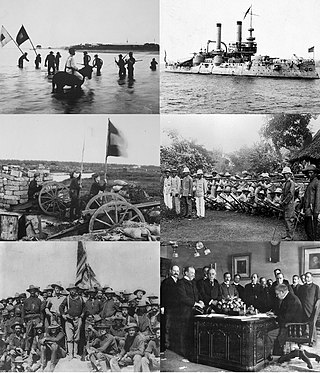
The Spanish–American War began in the aftermath of the internal explosion of USS Maine in Havana Harbor in Cuba, leading to United States intervention in the Cuban War of Independence. The war led to the United States emerging predominant in the Caribbean region, and resulted in U.S. acquisition of Puerto Rico, Guam, and the Philippines. It also led to United States involvement in the Philippine Revolution and later to the Philippine–American War.
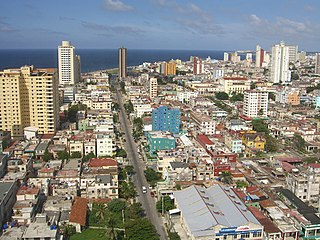
Havana is the capital and largest city of Cuba. The heart of the La Habana Province, Havana is the country's main port and commercial center. It is the most populous city, the largest by area, and the second largest metropolitan area in the Caribbean region. The population in 2012 was 2,154,454 inhabitants, and its area is 728.26 km2 (281.18 sq mi) for the capital city side and 8,475.57 km2 for the metropolitan zone.

Fulgencio Batista y Zaldívar was a Cuban military officer and politician who was the elected president of Cuba from 1940 to 1944 and military dictator of the country from 1952 until his overthrow in the Cuban Revolution in 1959.

Pedro de Alvarado was a Spanish conquistador and governor of Guatemala. He participated in the conquest of Cuba, in Juan de Grijalva's exploration of the coasts of the Yucatán Peninsula and the Gulf of Mexico, and in the conquest of the Aztec Empire led by Hernán Cortés. He is considered the conquistador of much of Central America, including Guatemala, Honduras, and El Salvador.
Bolero is a genre of song which originated in eastern Cuba in the late 19th century as part of the trova tradition. Unrelated to the older Spanish dance of the same name, bolero is characterized by sophisticated lyrics dealing with love. It has been called the "quintessential Latin American romantic song of the twentieth century".

Cuban cuisine is largely based on Spanish cuisine with influence from Taino, African and other Caribbean cuisines. Some Cuban recipes share spices and techniques with Spanish, Taino and African cooking, with some Caribbean influence in spice and flavor. This results in a blend of several different cultural influences. A small but noteworthy Chinese influence can also be accounted for, mainly in the Havana area. There is also some Italian influence. During colonial times, Cuba was an important port for trade, and the Spanish ancestors of Cubans brought with them the culinary traditions of different parts of Spain.
History Will Absolve Me is the title of a two-hour speech made by Fidel Castro on 16 October 1953. Castro made the speech in his own defense in court against the charges brought against him after he led an attack on the Moncada Barracks in Cuba. The speech later became the manifesto of his 26th of July Movement.
Senior colonel is an officer rank usually placed between a regular colonel and a British brigadier or American brigadier general.

Café Cubano is a type of espresso that originated in Cuba. Specifically, it refers to an espresso shot which is sweetened. However, the name can refer to coffee based drinks that include Cuban espresso as the main ingredient, such as café con leche.
The Escambray rebellion was an armed conflict from 1959 to 1965 in the Escambray Mountains during which several insurgent groups fought against the Cuban government led by Fidel Castro. The military operation against the rebellion was called the Struggle Against Bandits by the Cuban government.
Hugh Bicheno was a political risk analyst and an historian of conflict. He was best known for his interpretations of the Falklands War in Razor's Edge: The Unofficial History of the Falklands War and of the American Revolution in Rebels and Redcoats: The American Revolutionary War.
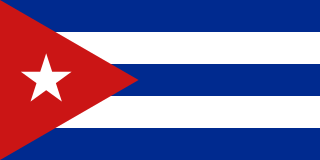
Cuba, officially the Republic of Cuba, is an island country, comprising the island of Cuba, Isla de la Juventud, and 4,195 islands, islets and cays surrounding the main island. It is located where the northern Caribbean Sea, Gulf of Mexico, and Atlantic Ocean meet. Cuba is located east of the Yucatán Peninsula (Mexico), south of both Florida and the Bahamas, west of Hispaniola, and north of Jamaica and the Cayman Islands. Havana is the largest city and capital. Cuba is the third-most populous country in the Caribbean after Haiti and the Dominican Republic, with about 10 million inhabitants. It is the largest country in the Caribbean by area.
Brigade 2506 was a CIA-sponsored group of Cuban exiles formed in 1960 to attempt the military overthrow of the Cuban government headed by Fidel Castro. It carried out the abortive Bay of Pigs Invasion landings in Cuba on 17 April 1961.

José Ramón Fernández Álvarez was a Cuban Communist leader who was a vice-president of the Council of Ministers.

The Captaincy General of Cuba was an administrative district of the Spanish Empire created in 1607 as part of Habsburg Spain attempt to better defend and administer its Caribbean possessions. The reform also established captaincies general in Puerto Rico, Guatemala and Yucatán.
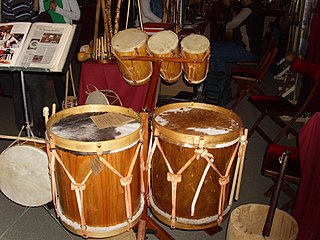
The bombo criollo, or simply bombo, is a family of Latin American drums derived from the European bass drum and native Latin American drum traditions. These drums are of smaller dimensions than the orchestral bass drum, and their frame can be made of wood or steel. They can be held vertically or diagonally on the body or a stand. The specific make of the instrument depends on the regional tradition. In Argentina, the bombo criollo is called bombo legüero and played in many folkloric styles. In Cuba, bombos are the largest drums played by the street comparsas in Santiago. In other countries, the term tambora is commonly used.
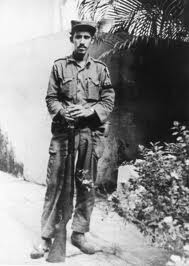
Efigenio Ameijeiras Delgado was a Cuban military commander affiliated with Fidel Castro from the 1950s. Son of Manuel Ameijeiras Fontelo, a native of Pontevedra (Spain) and the Cuban María de las Angustias Delgado Romo, from Corral Falso, in Matanzas. At the age of four, his father disappeared, so his mother had to take care of her children alone.
Gerard "Gerry" Droller was a German CIA officer involved in the covert 1954 Guatemalan coup d'état and the recruitment of Cuban exiles in the preparation of the Bay of Pigs Invasion in April 1961.

The Republic of Cuba, covering the historical period in Cuban history between 1902 and 1959, was an island country comprised the island of Cuba, as well as Isla de la Juventud and several minor archipelagos. It was located where the northern Caribbean Sea, Gulf of Mexico, and Atlantic Ocean meet. The period began in 1902 following the end of its first U.S. military occupation years after Cuba declared independence in 1898 from the Spanish Empire. This era included various changing governments and US military occupations, and ended with the outbreak of the Cuban Revolution in 1959. During this period, the United States exerted great influence on Cuban politics, notably through the Platt Amendment.